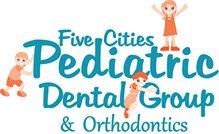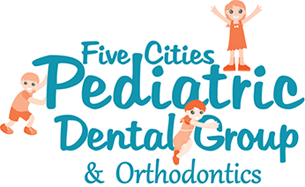A child's first visit to the dentist should be enjoyable. Children are not born with a natural fear of the dentist, but they can fear the unknown. Our office makes a special effort to use pleasant, non-frightening, simple words to describe each treatment. We want you and your child to feel at ease from the moment your family arrives at our office. The more you and your child know about the first visit, the better you will feel.
Adopting healthy oral hygiene habits
As your child's teeth erupt, be sure to examine them every two weeks, looking for lines and discoloration (white spots) that may be caused by decay. Remember that foods and liquids have sugars and starches that oral bacteria utilize to cause decay. We recommend brushing two times a day for optimal oral hygiene: once in the morning and once at night. Please be sure to floss any teeth that are touching together.
Your child should brush as soon as the first tooth erupts. When a baby's tooth erupts, parents should brush the tooth with a soft-bristled toothbrush and a rice grain-sized amount of fluoride toothpaste. For children 3 and over, a pea-sized amount of fluoride toothpaste can be safely be used.
Flossing is also a part of good oral hygiene habits, and our team will review the correct time to start flossing. If you notice signs of decay, contact us for a prompt consultation.
The American Academy of Pediatric Dentistry recommends...
Children should visit the dentist by their first birthday. It is important that your child's newly-erupted teeth (first erupting between 6-12 months of age) receive proper dental care and benefit from proper oral hygiene habits right from the beginning.
Getting to know your teeth is fun!
Download our Dynamite Dental Fun Kit!
When New Teeth Arrive
Your child's first primary or baby teeth will begin to erupt between the ages of six and 12 months, and will continue to erupt until about age three. During this time, your child's gums may feel tender and sore. To help alleviate this discomfort, we recommend that you soothe the gums by rubbing a clean finger or a cool, wet cloth across them. You may also choose to make use of a teething ring. When your child has finished teething, you can expect a total of 20 primary teeth.
Your child's primary teeth are shed at various times throughout childhood. Permanent teeth begin erupting at age six, and continue until age 21. Adults have 28 permanent teeth (32, including wisdom teeth).
Adopting Healthy Oral Hygiene Habits
As your child's teeth erupt, be sure to examine them every two weeks, looking for lines and discoloration (white spots) that may be caused by decay. Remember that foods and liquids have sugars and starches that bacteria in our mouths use to cause decay, so take care that your child brushes after feeding or eating. We recommend brushing twotimes a day for optimal oral hygiene: once in the morning and once at night.
Brushing can be fun, and your child should brush as soon as the first tooth arrives. When a baby's tooth erupts, parents should brush the tooth with a soft-bristled toothbrush and a pea-sized amount of toothpaste. For children younger than two, do not use fluoride toothpaste unless advised to do so by your dentist or other healthcare professional. We suggest reviewing proper tooth brushing procedures with your child.
Flossing is also a part of good oral hygiene habits, and your doctor will discuss with you the right time to start flossing. If you notice signs of decay, contact your dentist immediately.
Preventing Tooth Decay with Regular Checkups
Tooth decay is caused by sugars or starches left in the mouth that oral bacteria use to form acid which then weakens tooth structure, eventually causing cavities. Children are at high risk for tooth decay for a simple reason: many children and adolescents do not practice regular, good oral hygiene habits. Proper brushing and flossing routines combined with regular dental visits help keep tooth decay away.
Your child should visit the dentist every six months for regular dental cleanings and checkups. Twice yearly cleanings along with topical fluoride treatments help to keep teeth their strongest. Dental sealants are also recommended because they minimize the amount of food & bacteria that enter deep grooves in molar teeth, thereby preventing decay from forming in these hard-to-reach areas. Sealants can last for several years, and will be monitored at your child's regular checkups.
Laser dentistry
Certain dental procedures can be accomplished with a technologically advanced dental laser. Laser procedures may be done on hard oral tissues such as teeth, or soft tissues such as gums. One of the most noteworthy aspects of laser dentistry is that some procedures may be comfortably completed using little or no local anesthetic (novacain). Naturally, going home after your dental procedure wihout a numb cheek or lip is quite desirable, especially for a child! We're excited to offer this modern technology to our patients. Please inquire with one of our dentists to see if your child or adolescent might be a candidate for laser dentistry.
Tongue ties (ankyloglossia)
Tongue and lip ties, also known as tethered oral tissues, may interfere with a child's speech. Certain speech sounds may be difficult or impossible to pronounce if the tongue is restricted in its range of movement. This restriction also may impact the ability of a child to clear stuck food from certain areas of the mouth, thereby increasing the risk for caries (cavities). Moreover, the chewing and swallowing mechanism may be compromised by this condition. When appropriate, release of the restriction with a laser procedure can correct the problem. This release procedure may be called a frenulectomy or frenotomy. When completed with a dental laser, this procedure generally does not require any sutures (stitches) afterwards. Please don't hesitate to schedule a consultation with one of our pediatric dentists if you have a concern about tethered oral tissues in your child.


